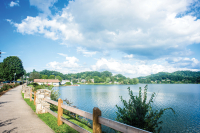World-class research taking place at Highlands Biological Station
Richard Baird, a plant pathologist from Mississippi State University, was hard at work one day last week examining mushrooms in a small laboratory at the Highlands Biological Station.
Baird is trying to determine which fungus might help Fraser firs grow more vigorously if it attaches to the roots, a symbiotic association called mycorrhiza. This is part of a new effort to reintroduce the adelgid-decimated tree into the Clingmans Dome area of the Great Smoky Mountains National Park. The seedling Fraser firs simply aren’t competing well currently with the lush understory of vegetation that’s there, and Baird’s task is to try to give the young trees the necessary boost to survive.
One other possible real-world application, Baird said, is that his work to help grow more stalwart Fraser firs also could help Christmas tree farmers do the same.
“This station really provides us the opportunity to do research in things we wouldn’t be able to do if it wasn’t here,” Baird said.
Tucked away just inside the town of Highlands, world-class research such as that conducted by Baird is taking place everyday at the Highlands Biological Station. More than a hundred students a year also study and work here, and visitors from far and wide come to visit the station’s 12 acres of native gardens and the natural history museum.
Related Items
Amateur roots
It may sound self evident, but biological stations are located and established in areas that are biologically interesting, said station director Jim Costa, who teaches in Western Carolina University’s department of biology.
“And Highlands, biologically, rivals any of the temperate regions of the world,” Costa said. “Because of that it’s attracted biological explorers for centuries. It’s such a remarkable place ecologically.”
A group of avid amateur naturalists living in Highlands had the idea for a museum in the 1920s.
“It started as a little museum in a one-room addition to the library,” Costa said.
Then, there was the decision to add a laboratory, and then the Highlands nature aficionados decided to ask some notable scientists to consider basing their work in Highlands. From those humble beginnings, the current biological station eventually emerged. The station moved into its current quarters in 1941, and the idea shortly emerged, too, to establish a botanical garden.
“The research and teaching snowballed over the years, and there was more and more of a presence here of faculty from the UNC schools,” Costa said.
For the first 50 years of the 85-year-old institution, the Highlands Biological Station was an independent nonprofit. But eventually, in 1976, it evolved into a state enterprise officially affiliated with the UNC system. Today, more than half of the annual $500,000 budget comes from state dollars.
The Highlands Biological Station is 23 acres in size. There are eight employees and four summer interns, and dormitory space to sleep 38.
Immersion learning
The Highlands Biological Station is best known for salamander research, plus botanical and fungal research, according to Costa.
“This region is renowned for its diversity of certain salamander groups, rivaled only by the rain forests for diversity,” he said.
In the salamander world, this region is known for the Lungless Salamander. This is a group of salamanders that breathe through the skin, having evolved without lungs. This means these salamanders need very moist, very healthy ecological conditions, Costa said, and Highlands is perfectly suited in those ways.
“People come from all over the world to study them,” he said. “It’s a huge and diverse family.”
Students are also coming to the Highlands Biological Station.
“The philosophy of education here is immersion,” Costa said. “These are full immersion courses. All day, everyday and into the weekend the students live these courses with the instructors.”
Costa said that’s very different from what takes place in a regular university setting. There, he said, students are unable to fully focus on one class as they can at the biological station.
Each year, 100 to 120 students participate in these immersion classes. The biological station also serves as a field trip destination for other university students in addition to the regular class schedule.
Intersecting with the public
Sonya Carpenter, administrative director of the Highlands Biological Station foundation, is tasked with helping the rubber meet the road: get the research out of the research lab and into the hands and minds of everyday folks.
“We’re the in-between for the researchers and the community, and we do that through programming,” Carpenter said.
One of the latest efforts has been the “Backyard Naturalists,” an after-school program designed to inspire a lifelong appreciation in children of the natural world through science, art and technology.
Carpenter said that with kids so focused on digital media these days, the program dovetailed technology and nature: kids learned to take photographs of wildlife plus worked together to develop a wiki, a website where they could freely add content and edit what was placed on the site. The kids took eight weeks of lessons, one afternoon per week, which were structured to promote a better appreciation and understanding of the natural world by nurturing creativity and independent observation skills.
The plan is to expand the program out of Highlands into other school systems this coming year.
There are also regular programs for the public conducted at the Highlands Biological Station, Carpenter said, so that regular people can learn from the scientists at work there.
“We’re trying to educate in a fun and interesting way,” she said.
Highlands Botanical Garden
This year the Highlands Botanical Garden is celebrating its 50th anniversary. The 12-acre garden at the Highlands Biological Station was established in 1962 as a refuge and demonstration garden for the diverse flora of the Southern Appalachian Mountains. Nearly 500 species of mosses, ferns, wildflowers, shrubs and trees flourish in natural forest, wetlands and old-growth plant communities connected by a series of trails and boardwalks. There are also demonstration gardens displaying collections of native Azaleas, plants of the Cherokee, mosses and liverworts, wildflowers, butterfly pollinated and rock outcrop species.
The garden is free and open to the public year-round from sunrise to sunset.









